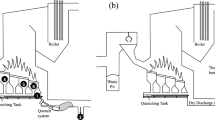Abstract
The following technological operations are suggested for reprocessing bottom residues from nuclear power plants: separation of radionuclides using oxidation, filtration, and selective absorption, solidification and long-term storage of secondary radioactive wastes (cement compound from filtration stage and spent sorbent in filters); concentration and obtaining dry salts from bottom residues from which radionuclides have been removed. Laboratory and stand tests have been performed, showing that radionuclides can be removed from the bottom residues of nuclear power plants to a level below the ASAsat according to NRB-96. This treatment decreases the volume of radioactive wastes by approximately a factor of 100. The dried purified bottom residues, which are commercial danger class III wastes, are shipped to storage sites used for industrial wastes. Calculations of the material flows are performed and the site arrangement of the wastes is given for the bottom residues from the Kursk nuclear power plant. 1 figure, 2 tables, 12 references.
Similar content being viewed by others
REFERENCES
A. S. Nikiforov, V. V. Kulichenko, and M. I. Zhikharev, Neutralizing Liquid Radioactive Wastes [in Russian], Énergoatomizdat, Moscow (1985).
Yu. K. Babenko, A. P. Mel'nikov, and K. V. Dramaretskii, "Problems of handling radioactive wastes at the Novovoronezh nuclear power plant," in: Abstracts of Reports at the International Conference "Radioactive Wastes.Storage, Shipment, Reprocessing.Effect on Man and the Environment," St. Petersburg, October 1996, p. E8.
"Bitumenization processes to condition radioactive wastes," IAEA Technical Report, Series No. 352, Vienna (1993).
"Design and operation of high level wastes vitrification and storage facilities," IAEA Technical Report, Series No. 339, Vienna (1992).
A. S. Polyakov, N. I. Moiseenko, V. I. Osnovin, et al., "Experience in operating the ÉP-500/1R ceramic melter for vitrifying liquid high-level wastes," At.Énerg., 76, No. 3, 183–188 (1994).
I. A. Sobolev, F. A. Lifanov, S. V. Stefanovskii, et al., "Vitrification of radioactive wastes by induction melting in a cold crucible," Fiz.Khim.Obrab.Mater., No. 4–5, 161–170 (1994).
"Advances in technologies for the treatment of low and intermediate level radioactive liquid wastes," IAEA Technical Report No. 370, Vienna (1994).
R. Harjula, Y. Lehto, E. Tusa, and A. Paavola, "Industrial scale removal of cesium with hexacyanoferrate exchanger-process development," Nucl.Technol., 107, No. 3, 272–278 (1994).
Handbook of the Maximum Admissable Concentrations of Harmful Substances in Air and Water [in Russian], Khimiya, Leningrad (1972).
G. P. Bespamyatnov and Yu. A. Krotov, Handbook of Maximum Admissable Concentrations of Chemical Substances in the Environment [in Russian], Khimiya, Leningrad Division, Leningrad (1985).
Building Standards and Rules 2.01.28–85. Sites for neutralization and storage of toxic industrial wastes. Basic design principles.
V. V. Raznoshchik, Design and Operation of Sites for Solid Domestic Wastes [in Russian], Stroiizdat, Moscow (1981).
Author information
Authors and Affiliations
Rights and permissions
About this article
Cite this article
Dmitriev, S.A., Lifanov, F.A., Savkin, A.E. et al. Handling of the Bottom Residues of a Nuclear Power Plant. Atomic Energy 89, 884–889 (2000). https://doi.org/10.1023/A:1011338231351
Issue Date:
DOI: https://doi.org/10.1023/A:1011338231351




